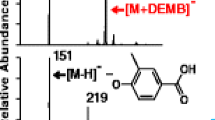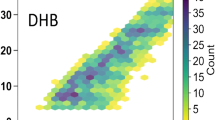Abstract
Structural elucidation of lignin degradation products is a requirement for successfully developing lignin valorization technology. Most of mass spectrometry–based techniques have utilized negative ion mode mass spectrometry for structural elucidation of lignin-derived compounds. Unfortunately, simple deprotonation can lead to in-source fragmentation and may not be suitable for condensed lignin structures without acidic moieties. Herein, we present a lithium cationization methodology for mass spectrometry sequencing of advanced lignin oligomers having β-β′ and β-O-4′ bonding motifs. To do so, two advanced lignin oligomers were first synthesized through a step-by-step synthetic route, and then subjected to two different ESI mass spectrometry techniques in positive ion mode using lithium cations for ionization. An orbitrap mass spectrometer was used to obtain exact mass information, and higher-energy collisional dissociation (HCD) was used to sequence the lignin model oligomers. Based on the sequence-specific fragment ions, sequence rules were proposed. Multi-stage (MSn) collision-induced dissociation (CID) using an ion trap mass spectrometer provided data to investigate the origin of each fragment ion and to further confirm proposed fragmentation pathways. In addition to β-O-4′ bond cleavage, the presented lithium cationization approach led to cleavage of β-β′ bonds on the model oligomers in both ion trap and orbitrap mass spectrometry experiments. Additionally, MSn experiments were used to investigate possible lithium cationization sites on the model oligomers. Lithium cationization in positive ion mode mass spectrometry proved to be a robust tool for characterization and sequencing of advanced lignin oligomers with different bonding motifs.
Graphical abstract












Similar content being viewed by others
Change history
14 July 2022
A Correction to this paper has been published: https://doi.org/10.1007/s00216-022-04187-0
References
Karunarathna MS, Smith RC. Valorization of lignin as a sustainable component of structural materials and composites: advances from 2011 to 2019. Sustainability. 2020;12(2).
Zakzeski J, Bruijnincx PCA, Jongerius AL, Weckhuysen BM. The catalytic valorization of lignin for the production of renewable chemicals. Chem Rev. 2010;110(6):3552–99.
Huang K, Ma S, Wang S, Li Q, Wu Z, Liu J, et al. Sustainable valorization of lignin with levulinic acid and its application in polyimine thermosets. Green Chem. 2019;21(18):4964–70.
Wang S, Su S, Xiao L-P, Wang B, Sun R-C, Song G. Catechyl lignin extracted from castor seed coats using deep eutectic solvents: characterization and depolymerization. ACS Sustain Chem Eng. 2020;8(18):7031–8.
Liu X, Li T, Wu S, Ma H, Yin Y. Structural characterization and comparison of enzymatic and deep eutectic solvents isolated lignin from various green processes: toward lignin valorization. Bioresour Technol. 2020;310:123460.
Neiva DM, Rencoret J, Marques G, Gutiérrez A, Gominho J, Pereira H, et al. Lignin from tree barks: chemical structure and valorization. ChemSusChem. 2020;13(17):4537–47.
Wang H, Pu Y, Ragauskas A, Yang B. From lignin to valuable products–strategies, challenges, and prospects. Bioresour Technol. 2019;271:449–61.
Morreel K, Kim H, Lu F, Dima O, Akiyama T, Vanholme R, et al. Mass spectrometry-based fragmentation as an identification tool in lignomics. Anal Chem. 2010;82(19):8095–105.
Morreel K, Dima O, Kim H, Lu F, Niculaes C, Vanholme R, et al. Mass spectrometry-based sequencing of lignin oligomers. Plant Physiol. 2010;153(4):1464–78.
Asare SO, Huang F, Lynn BC. Characterization and sequencing of lithium cationized β-O-4 lignin oligomers using higher-energy collisional dissociation mass spectrometry. Anal Chim Acta. 2019;1047:104–14.
Evtuguin DV, Amado FML. Application of electrospray ionization mass spectrometry to the elucidation of the primary structure of lignin. Macromol Biosci. 2003;3(7):339–43.
Kiyota E, Mazzafera P, Sawaya ACHF. Analysis of soluble lignin in sugarcane by ultrahigh performance liquid chromatography–tandem mass spectrometry with a do-it-yourself oligomer database. Anal Chem. 2012;84(16):7015–20.
Kosyakov DS, Ul'yanovskii NV, Anikeenko EA, Gorbova NS. Negative ion mode atmospheric pressure ionization methods in lignin mass spectrometry: a comparative study. Rapid Commun Mass Spectrom. 2016;30(19):2099–108.
Zhang R, Qi Y, Ma C, Ge J, Hu Q, Yue FJ, et al. Characterization of lignin compounds at the molecular level: mass spectrometry analysis and raw data processing. Molecules (Basel, Switzerland). 2021;26(1).
Dean KR, Lynn BC. Lithium cation basicity estimates of lignin β-O-4 dimers by the kinetic method utilizing a novel ladder approach. Int J Mass Spectrom. 2020;457:116416.
Bowman AS, Asare SO, Lynn BC. Matrix-assisted laser desorption/ionization time-of-flight mass spectrometry analysis for characterization of lignin oligomers using cationization techniques and 2,5-dihydroxyacetophenone (DHAP) matrix. Rapid Commun Mass Spectrom. 2019;33(8):811–9.
Lahive CW, Kamer PCJ, Lancefield CS, Deuss PJ. An introduction to model compounds of lignin linking motifs; synthesis and selection considerations for reactivity studies. ChemSusChem. 2020;13(17):4238–65.
Letourneau DR, Volmer DA. Mass spectrometry-based methods for the advanced characterization and structural analysis of lignin: a review. Mass Spectrom Rev. 2021;n/a(n/a).
Li A, Hou X, Wei Y. Fast screening of flavonoids from switchgrass and Mikania micrantha by liquid chromatography hybrid-ion trap time-of-flight mass spectrometry. Anal Methods. 2018;10(1):109–22.
Sheng H, Tang W, Gao J, Riedeman J, Hurt M, Yang L, et al. Characterization of ionized lignin model compounds with α-O-4 linkages by positive- and negative-ion mode electrospray ionization tandem mass spectrometry based on collision-activated dissociation. Rapid Commun Mass Spectrom. 2021;35(8):e9057.
Andrianova AA, DiProspero T, Geib C, Smoliakova IP, Kozliak EI, Kubátová A. Electrospray ionization with high-resolution mass spectrometry as a tool for lignomics: lignin mass spectrum deconvolution. J Am Soc Mass Spectrom. 2018;29(5):1044–59.
Olsher U, Izatt RM, Bradshaw JS, Dalley NK. Coordination chemistry of lithium ion: a crystal and molecular structure review. Chem Rev. 1991;91(2):137–64.
Plenio H. The coordination chemistry of the CF unit in fluorocarbons. Chem Rev. 1997;97(8):3363–84.
Pearson RG. Chemical hardness. Place of publication not identified: Wiley VCH; 1997.
Lopachin RM, Gavin T, Decaprio A, Barber DS. Application of the Hard and Soft, Acids and Bases (HSAB) theory to toxicant--target interactions. Chem Res Toxicol. 2012;25(2):239–51.
Acknowledgements
This research was funded by the National Science Foundation EPSCor Track 2 (OAI 1632854).
Author information
Authors and Affiliations
Corresponding author
Ethics declarations
Conflict of interest
The authors declare no competing interests.
Additional information
Publisher’s note
Springer Nature remains neutral with regard to jurisdictional claims in published maps and institutional affiliations.
The original online version of this article was revised: Figures 2 and 4 has been updated.
Supplementary Information
Below is the link to the electronic supplementary material.
Rights and permissions
About this article
Cite this article
Dorrani, M., Lynn, B.C. Application of lithium cationization tandem mass spectrometry for structural analysis of lignin model oligomers with β-β′ and β-O-4′ linkages. Anal Bioanal Chem 414, 5755–5771 (2022). https://doi.org/10.1007/s00216-022-04111-6
Received:
Revised:
Accepted:
Published:
Issue Date:
DOI: https://doi.org/10.1007/s00216-022-04111-6




